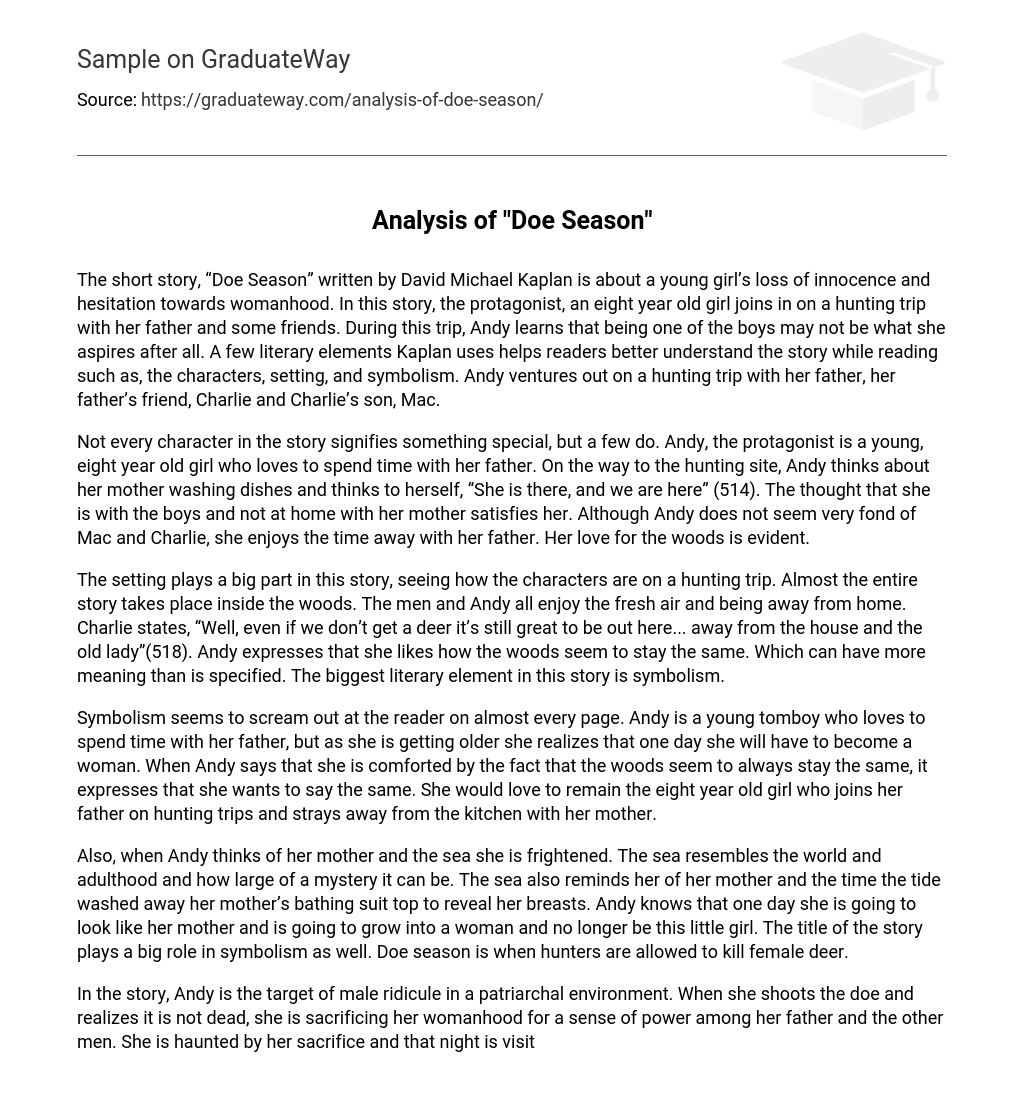The short story, “Doe Season” written by David Michael Kaplan is about a young girl’s loss of innocence and hesitation towards womanhood. In this story, the protagonist, an eight year old girl joins in on a hunting trip with her father and some friends. During this trip, Andy learns that being one of the boys may not be what she aspires after all. A few literary elements Kaplan uses helps readers better understand the story while reading such as, the characters, setting, and symbolism. Andy ventures out on a hunting trip with her father, her father’s friend, Charlie and Charlie’s son, Mac.
Not every character in the story signifies something special, but a few do. Andy, the protagonist is a young, eight year old girl who loves to spend time with her father. On the way to the hunting site, Andy thinks about her mother washing dishes and thinks to herself, “She is there, and we are here” (514). The thought that she is with the boys and not at home with her mother satisfies her. Although Andy does not seem very fond of Mac and Charlie, she enjoys the time away with her father. Her love for the woods is evident.
The setting plays a big part in this story, seeing how the characters are on a hunting trip. Almost the entire story takes place inside the woods. The men and Andy all enjoy the fresh air and being away from home. Charlie states, “Well, even if we don’t get a deer it’s still great to be out here… away from the house and the old lady”(518). Andy expresses that she likes how the woods seem to stay the same. Which can have more meaning than is specified. The biggest literary element in this story is symbolism.
Symbolism seems to scream out at the reader on almost every page. Andy is a young tomboy who loves to spend time with her father, but as she is getting older she realizes that one day she will have to become a woman. When Andy says that she is comforted by the fact that the woods seem to always stay the same, it expresses that she wants to say the same. She would love to remain the eight year old girl who joins her father on hunting trips and strays away from the kitchen with her mother.
Also, when Andy thinks of her mother and the sea she is frightened. The sea resembles the world and adulthood and how large of a mystery it can be. The sea also reminds her of her mother and the time the tide washed away her mother’s bathing suit top to reveal her breasts. Andy knows that one day she is going to look like her mother and is going to grow into a woman and no longer be this little girl. The title of the story plays a big role in symbolism as well. Doe season is when hunters are allowed to kill female deer.
In the story, Andy is the target of male ridicule in a patriarchal environment. When she shoots the doe and realizes it is not dead, she is sacrificing her womanhood for a sense of power among her father and the other men. She is haunted by her sacrifice and that night is visited by an owl and the doe she had shot. The next day when she sees that the doe is dead, she realizes her inner truth and realizes that she no longer wants to be Andy, but her true self, Andrea.
Andy now understands that growing up and becoming who she is truly meant to be is inevitable. while all around her roared the mocking of the terrible, now inevitable, sea” (523). “Doe Season” is a great coming-of-age story. It deals with the struggle of a young woman not wanting to face the terrible fear of reality. Kaplan uses elements to help the reader better understand the story. These are the building blocks of the story. Although there are many, symbolism outweighs them all. The symbolism used, is in a way that can make the reader relate and sympathize with the protagonist.





